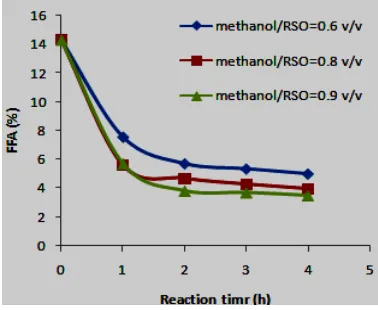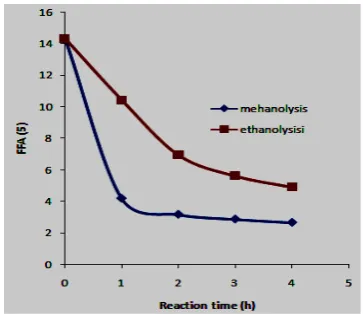ICETEA 2015
-- Page 40 of 115 --
ISSN 2470
-
4330
Comparative Free Fatty Acid (FFA) Removal in
Crude Rubber Seed Oil between Methanol and
Ethanol on Acid Esterification Process for Biodiesel
Production
Maria Ulfah
#, Mulyazmi
#, Silvi Octavia
#, Burmawi
*#Department of Chemical Engineering, Universitas Bung Hatta, Padang, Indonesia *Department of Mechanical Engineering, Universitas Bung Hatta, Padang, Indonesia
Jl. Gajah Mada No. 19, Nanggalo Olo, Padang- Indonesia
1
Abstract— Rubber seed Oils (RSO) with high content of FFA can be treated by acid esterfication where an alcohol reacts with RSO in the presence of acid catalyst. Methanol and ethanol are the most widely that used in biodiesel process. This study aims to comparative FFA removal degree in crude RSO between methanol and ethanol on acid esterification process. The optimum conditions for acid esterification which use methanol were 0.9 v/v methanol to oil ratio, and 0.5 vol. % H2SO4 after 4 h. The FFA removal rate for using methanol reached 82%. Under the conditions of 0,9 v/v ethanol to oil ratio, 60 oC, and 0.5 vol. % H2SO4 after 4 h, the FFA removal rate of esterification reached 66%.
Keywords
—
acid-esterifiacation, FFA removal, rubber seed oilsI. INTRODUCTION
There is a realization throughout the world that the petroleum resources which are non-renewable are being rapidly depleted. The growing demand for energy and gradual disappearance of fossil fuels may lead to servere energy crisis. World over researchers are looking for an alternative renewable and eco-friendly source of energy arises. One of such is biodiesel [1].
However, biodiesel is currently not cost competitive with conventional diesel fuel due to its high raw material and production costs. According to previous reports, the raw materials for biodiesel production account for almost 75% of the total biodiesel cost [2]. To reduce the cost of biodiesel, in general, the selection of oil feed is very critical. Therefore, non-edible vegetable oils are become more attractive for biodiesel production. Non-edible oilseed crops include Rubber seed, Jatropha curcus, Catton seed, Tobacco seed, Cumaru, Cynara cardunculus, Abutilon muticum, Neem, Jojoba, Passion seed, Moringa, Coffe ground, Nagchampa, Croton megalocarpus, Pachira glabra, Aleurites moluccana and Terminalia belerica [1]. Nevertheless, such oils usually contain a high percentage of free fatty acid (FFAs) that severely affect the biodiesel production process [2].
Indonesia is a country with a largest rubber land area of
the world’s with vast acreage totalled 3.4 million hectares,
with rubber production reached 2.6 million tons in 2009. On the other side, rubber seeds are not much utilized, whereas oil levels contained are quite high 40-50%. Therefore, utilization of rubber seeds as raw material for biodiesel production is very promising [3].
A.S. Ramadhas et.al (2005) had found that FFA content in the crude rubber seed oil (RSO) was about 17%. This FFA value is significantly high and obstructs the transesterification process in the methyl ester production. It has been confirmed that the ester yield decreases with increasing in FFA significantly. Usually, the alkaline-catalyzed transesterification takes place well only with refined oil having FFA value of less than 2%. Therefore, the single step alkaline-catalyzed transesterification process is not suitable to produce methyl esters from high FFA crude oil [5].
Two step transesterification process method is used for the production of biodiesel from feedstocks containing high free fatty acids. The first step is the esterification of FFA to fatty acid methyl esther (FAME) followed by a second step, alkaline-catalyzed transesterification. However, acid catalyst are incorporated in the production process for feedstock of high FFA content. Liquid acids, such as sulfuric acid and hydrochloric acid, are usually used as acid-catalysts, the former being the most commonly used catalyst in esterification process [6].
Different types of alcohols can be used to produces biodiesel such as methanol, ethanol, propanol, and butanol. Nevertheless, methanol and ethanol are the most widely that used in biodiesel process [7]. Methanol is more preferred over ethanol due to its high reaction rate but later one is renewable and derived from agricultural sources [1].
ICETEA 2015
-- Page 41 of 115 --
ISSN 2470
-
4330
II. EXPERIMENTAL
A. Chemical
Methanol, ethanol, sulphuric acid and phenolphthalein used were analytical reagent grade, while n-hexane that used in the experiment is technical grade.
B. Rubber Seeds and Extraction
The rubber seed was obtained from the rubber tree plantation area located Pasaman Timur, Padang, Indonesia. Rubber seeds were first de-shelled and dried at 50 oC for 12 h. The dried seeds were finely crushed and oven–dried at 60 oC overnight. Subsequently 100 g of the crushed seed was weighed into a glass jar, and the oil was extracted with 600 ml of n-hexane for 4 h at 60 oC. The solvent, n-hexane was separated from the crude rubber seed oil using a destillator.
C. Esterification Procedure
The esterification reaction was carried out in a 500 ml three neck flask, with a hot plate, thermometer, stirrer, and condenser. A certain amount of the rubber seed oil was fed into the batch reactor. Then the desired amounts of methanol and sulphuric acid were added into the batch reactor and the reaction began under the required conditions. The basic reaction conditions were oil amount 40 mL, methanol/oil volume ratio 60%, catalyst amount 0.5%, reaction temperature 60 °C and reaction time 4 h. Samples were withdrawn at one hour intervals. The above procedure is repeated for the esterification of RSO with ethanol but using optimum conditions obtained from rubber seed oil esterification with methanol
.
D. Determination of the Percentage Free Fatty Acid (FFA)
Phenolphthalein (0.5 mL) used as an indicator was added to sample (2,5 g). The sample was then titrated with 0.1 N NaOH solution. The acid value was calculated using Equation (1):
��� % =25.6 .�.�
� � 100% (1)
where FFA is the free fatty acid (%); c is the concentration of the NaOH used for titration (mol/L); V is the volume of NaOH employed for titration (mL); m is the weight of the sample taken to be analyzed (g).
III.RESULT AND DISCUSSION
The important parameters affecting the acid esterification step such as molar ratio between RSO and methanol, catalyst (sulfuric acid) amount, and type of alcohol are investigated.
A. Effect of Methanol/RSO Ratios on the Esterification
Theoretically, the esterification reaction requires one mole of methanol for each mole of FFA. However, in practice, the methanol should be in excess to drive the reaction towards completion as the esterification of FFA (equation 2) with methanol is reversible [8].
�����+��3�� <− − −−>������3+ �2� (2)
FFA Methanol Methyl ester water
In order to study the effect of methanol/RSO volume ratios on esterification, different experiments were carried out using different methanol/RCO volume ratios of 0.6 v/v, 0.8 v/v, and 0.9 v/v, as shown in Figure 1. The FFA percentage decreased from 5.02 to 3.48 when the methanol/RSO volume ratio was increased from 0.6 to 0.9 after a reaction time of 4 h under the conditions of 0.5% sulphuric acid and a reaction temperature of 60 ºC. The FFA percentage decreased only slightly from 3.99 to 3.48 when the methanol/RSO volume ratio rose from 0.8 v/v to 0.9 v/v. With further increases in volume ratio there is little decrease in the FFA percetage. Therefore, the optimized methanol/RSO volume ratio was determined to be 0.9 v/v in this reaction system.
Fig.1The influence of methanol to oil molar ratio
B. Effect of the Amount of Sulphuric Acid on the Esterification
ICETEA 2015
-- Page 42 of 115 --
ISSN 2470
-
4330
Fig. 2Effect of the amount of sulphuric acid on the esterification
C. Comparison between Methanol with Ethanol on the Acid Esterification
Many different alcohols can be used in this reaction including, methanol, ethanol, propanol, and butanol. The effect of type alcohols (methanol and ethanol) on the esterification of RSO was investigated by carrying out the experiment at a fixed methanol/RSO ratio of 0.9 v/v and amount of sulphuric acid of 0.5 % with a reaction time of 4 h. The experimental temperature was in the range from 60 °C to 65 °C, as shown in Figure 3. It was observed that using the methanol had a favorable influence on the degree of esterification. With methanol, the acid removal rate of esterification product decreased from 14.33% to 2.66%. However, with ethanol, the acid removal rate of esterification product decreased from 14.33% to 4.92%. With use methanol, the FFA percentage decreased at a faster rate. The methanol application is more feasible because of its low cost and physical as well as chemical advantages such as being polar and having the shortest chain alcohol [9].
Fig. 3Effect of between methanol and ethanol
on the esterification
IV.CONCLUSIONS
In this study, methanol showed high FFA removal rate of acid esterification of free fatty acid in crude rubber seed oil. Under the conditions of 0,9 v/v methanol to oil ratio, 60 oC,
and 0.5 vol. % H2SO4 after 4 h, the FFA removal rate of
esterification reached 82%. With ethanol, the acid removal rate of esterification product decreased 66% when 0,9 v/v ethanol to oil ratio, 60 oC, and 0.5 vol. % H2SO4 after 4 h.
ACKNOWLEDGMENT
The authors are grateful to Directorate General of Higher Education, Ministry of Research and Technology, National Education of Indonesia in providing a grant to conduct this reasearch.
REFERENCES
[1] A.N. Utomo,‖ Alternative transesterification methods for biodiesl production-A review,‖ Proc. CISAK, C2/P/18, 2013.
[2] A.S. Ramadhas, S. Jayaraj, and C. Muraleedharan,‖ Biodiesel production from high FFA rubber seed oil,‖ Vol.84, pp. 335-340, 2005.
[3] J. Ding, Z. Xia, and J. Lu,‖Esterification and deactification of a waste cooking oil (TAN 68.81 mg KOH/g) for biodiesel production,‖
Energies, pp. 2683-2691, 2012.
[4] Ma, and M.A Hanna,‖ Biodiesel production: a review,‖ Bioresour Technol, 70, pp. 1-15, 1999.
[5] P. Thaiyasuit, K. Pianthong, and I. Worapun,‖ Acid esterification-alkaline transesterification process for methyl ester production from crude rubber seed oil,” J. Oleo. Sci.Vol. 61, (2) 81-88, 2012. [6] S. Chongkhong, U. Kanjaikaew, and C, Tongurai,‖ A Review of FFA
esterification for biodiesel production,” in Proc. PSU, May 14-15, 2012.
[7] S. Mohite, S. Kumar, A. Pal, and S. Maji, ―Biodiesel production from high free fatty acid feed stocks through transesterication,‖ in Proc. ICARI, pp. 113-115, 2015.
[8] U. Krishnakumar, V. Sivasubramanian and V. Selvaraju,‖Physico-chemical properties of the biodiesel extracted from rubber seed oil using solid metal oxide catlysts,‖ International Journal of Engineering Research and Application (IJERA), vol. 3, Issue 4, pp. 2206-2209, 2013.

